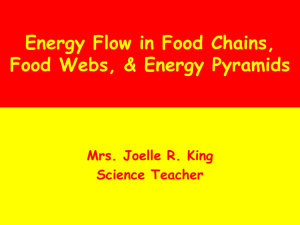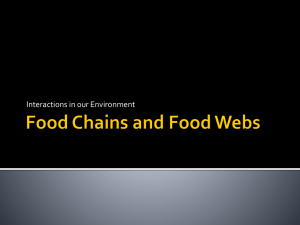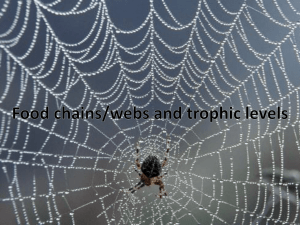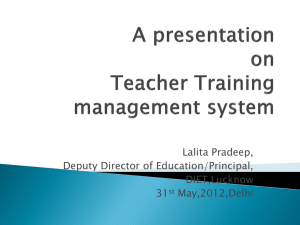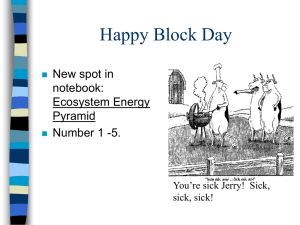Environmental Biology (Energy Flow)
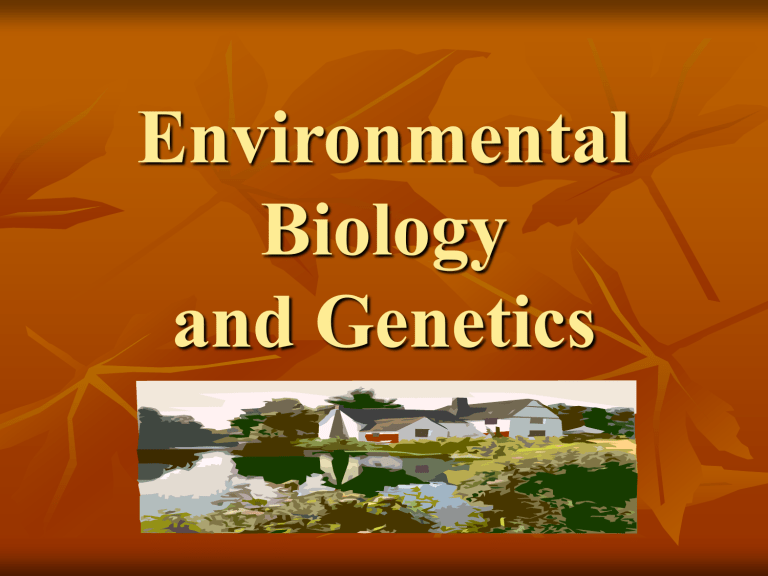
Environmental
Biology and Genetics
Energy Flow
Ecology
–
The study of living organisms in relation to their environment
Organism
–
Living thing
Habitat – The place where an organism lives
Population
– The total number of one type of organism living in any one habitat
Community
– The different populations of plants, animals and micro-organisms found in a particular habitat
Ecosystem
– A natural biological unit which is made up of living and non-living parts
All the energy in an ecosystem comes from the sun
Green plants are able to convert light energy from the sun into chemical energy (starch) during photosynthesis
Green plants are called producers because they are able to produce their own food
Other organisms can not produce their own food, so must eat (consume) these plants and/or animals
They are known as consumers
Three types of consumers;
Herbivores - Eat only plant material
Carnivores - Eat only meat (animal) tissue
Omnivores - Eat both plant and animal tissue
An animal that hunts another animal is called a predator
The animal being hunted is the prey
Decomposers are micro-organisms ie. Bacteria and fungi, which get their energy from breaking down waste materials
Now complete pages 1 and 2 of your sheets. (Use pg 109 of the textbook to help)
Food Chains / Webs
When an animal eats a plant or animal energy is transferred from the food to the feeder
The animal that eats the plant at the start of a feeding relationship is called the primary consumer
(Normally a herbivore may be an omnivore)
If the primary consumer is eaten by a second animal, this second animal is called the secondary consumer
(may be an omnivore or a carnivore)
Energy transfer continues the whole way along the feeding relationship. This is known as a food chain.
Food Chains
A food chain always begins with a producer or detritus
Eg.
Grass Rabbit Fox
(Producer) (1st consumer) (2nd consumer)
The arrows indicate the direction of energy transfer.
Food Webs
In nature a food chain rarely occurs in isolation
The producer may be eaten by a number of different animals, which in turn may be preyed upon by many different predators
(See pg 3 of sheets, pgs 110 – 112 of text )
Food chains interconnect at many points to form a food web
Look at the following food web and pick out at least 5 different food chains;
Fox Merlin Skylark Eagle
Mountain Hare Grouse
Moth Larva
Heather
Food Webs
Pick out all the food chains from this web;
Frog
Snail
Fox
Hedgehog
Vole
Owl
Weasel
Rabbit
Primrose Oak
Energy Loss
Not all the energy available at each step of the food chain is passed on to the next step (See sheets pg 4)
There is a significant energy loss at each step of a food chain
Some energy not used
90% lost and is unavailable to other animals
Some energy used
Energy from food
100% 10% is passed on to other animals (this energy is stored in the tissue of the plant or animal, until it is eaten) uneaten undigested
Lost as heat
Used for movement
Pyramid of Numbers
In most food chains there is a greater number of producers than primary consumers, and a greater number of primary consumers than secondary consumers, and so on
The final consumer is least numerous
This numerical relationship is called a pyramid of numbers.
As the organism higher in the food chain requires more food, the level before it in the pyramid is bigger
This is due to a decrease in energy being passed on.
Primrose Snail
Pyramid of Numbers
Hedgehog Fox
Decreasing numbers
Decreasing energy
FOX
HEDGHOG
SNAIL
PRIMROSE
Pyramid of Numbers
In some food chains the producer is a single large plant and the pyramid therefore takes a different form.
Oak Tree Caterpillar Shrew Owl
Owl
Shrew
Caterpillar
O
T
Pyramid of Biomass
The biomass of a population is its total mass of living matter
The biomass at each level of the pyramid decreases
This can be represented as a pyramid of biomass
As there are so many organisms at each level of the pyramid, the weight decreases with the numbers.
Primrose Snail
Pyramid of Biomass
Hedgehog Fox
Decrease in biomass
FOX
HEDGEHOG
SNAIL
PRIMROSE
Pyramid of Energy
The most reliable comparison between organisms found at different levels of a food chain is in a pyramid of energy
This is based on productivity
This is measured as dry mass per square metre per year, before being converted into kilojoules per square metre per year.
This type of pyramid will always take the shape of a true pyramid, as only a proportion of energy is transferred from one level to the next.
(Complete pgs 3-6 of sheets)
Test your knowledge pgs 113 + 118 of text
Apply your knowledge pgs 119-122 of text
FOX
HEDGHOG
SNAIL
PRIMROSE
Factors Affecting The Variety of
Species in an Ecosystem
Species
–
A group of living organisms which are so similar to one another that they are able to interbreed and produce fertile offspring
Biodiversity
Within an ecosystem there is a variety of habitats
Within each habitat there is a range of populations (plants, animals and micro-organisms)
As well as being adapted to their habitat, each population is adapted to a particular ecological niche in the pattern of the community
As an ecosystem develops over a period of time the range of habitats and niches it contains increases
This gives rise to a wide diversity of species in every ecosystem
An adaptation is an inherited characteristic that makes an organism well suited to survival in its environment
Some adaptations involve the structure of the organism’s body, or a behavioural response to a particular environmental stimuli
Adaptation can leave some species unable to cope with other/different habitats, environmental conditions
This means that some species will only be found in an area where the conditions are suitable to its survival needs, influencing its distribution in the ecosystem
A stable ecosystem contains a balance of interdependent producers, consumers and decomposers
(Complete pgs 7 and 8 of sheets, use pgs 123-128 of text)
Test your knowledge pg 127
Importance of Biodiversity
1. Could provide us with future life changing medicines
2. May provide us with a genetic storehouse in many wild species which could help humans and plants recover from disease
3.
Could provide us with future varieties of food
4. May add to our education of the nature around us.
(Sheets page 14, see text pgs 139-140)
Factors such as pollution and grazing reduce the variety of species in an ecosystem
They act selectively on populations disadvantaging some species and allowing others to thrive by eliminating their competition.
Reduction in Biodiversity
Human activity can reduce biodiversity through the destruction of habitats
(Pages 8-13, see text pgs 129 - 138), ie;
Disruption of food webs
Grazing
Pollution – Acid rain
- Sewage
- Thermal pollution
Deforestation
Desertification
Mass extinction
Over-hunting
Habitat destruction
Disruption of Food Webs
Food webs are generally more stable than food chains, and can normally withstand small/ temporary disruptions
If , however an organism is affected by an external factor, then this will have a knock-on effect in a food chain
A chain having only a few links will be more seriously affected than a longer chain
Myxomatosis is an example of an external factor which nearly wiped out the rabbit population in
Britain
Grazing
Grazing can be of an advantage to some plant species and a disadvantage to others
If natural grasslands go un-grazed, some of the stronger species will thrive on the available resources, causing other weaker species to die
This reduces biodiversity
If on the other hand, animals are left to over-graze, this can also lead to a reduction in biodiversity
This is because the plants are not able to grow and reproduce.
Pollution
Acid Rain
Caused by the burning of fossil fuels (coal, oil)
Release sulphur dioxide (poisonous gas), damages many plant species
Ie.different Lichen species tolerate different levels of SO
2 pollution
As air pollution increases, the variety of lichen species decreases
Water and land environments can also be affected by pollution
Ie. a reduction in the number of fish species
Sewage
Untreated sewage may be released into rivers in densely populated areas if the sewage works become overloaded
This provides food for bacteria (which feed on organic waste)
(Organic waste ie. Dead skin cells, faeces, urine, hair, plant/animal food waste)
As sewage bacteria oxygen fish etc.
This could result in loss of clean water species ie. Loss of species diversity
Thermal Pollution
Some power stations use local river water to cool their generators
When the water is returned to the river it is considerably warmer, and causes thermal pollution
Deforestation
The complete clearing of vast areas of natural forests and the failure to plant new forests in their place;
Loss of regular water flow, so loss of sponge effect = rivers fail to provide a regular supply of water for human consumption and irrigation
Loss of rain water from hillsides = flooding of low-lying downstream areas, cannot be cultivated
Erosion of fertile top soil = fertility of hillside reduced, rivers, lakes, irrigation channels and dams become blocked, muddy and undrinkable
Less water evaporation into atmosphere = reduction in rainfall, so drier climate
More CO
2
(burning) not removed by photosynthesis and less O
2
= extra carbon dioxide may add to the greenhouse effect.
Desertification
Removal of protective shrubs and plants which act as wind breaks which normally hold the soil together
Removal causes the soil to dry out and lose fertility.
Mass Extinction, Over-hunting and
Habitat destruction
Fossil fuels take millions of years to form, and are quickly becoming depleted due to over use
As they take so long to form it will take as long again to form more
Hundreds of birds and animals have become extinct over the centuries, and many more are in danger
Two major contributors are over-hunting and habitat destruction
Human activities are causing the current wave of extinction to run at about 400 times its natural rate.
(See pgs 8-13)
Test your knowledge pg 141 of text.
Behavioural Adaptations in Animals
Animals exhibit behavioural responses to their environment
Behavioural responses/adaptations are of survival value to the animal
The way an animal responds depends on the environmental stimulus which it has triggered its internal receptors
Theses receptors are linked with the sense organs which in turn communicate with the nervous system
The sense organ detects an environmental stimulus then transmits nerve impulses through the nervous system, causing an effector to create a behavioural response
The effector could be muscles or glands.
(See pgs15-17)
Pg 16/17 Activity 2.1, text pgs 143 - 144
Pg 17/18 Activity 2.2, text pgs 145 -147
Testing your knowledge pg 147 of text.
Competition Between Plants
If any of the following resources are in short supply plants will compete with one another for them;
Light
Water
Soil Nutrients
Same species plants will have intense competition for these resources. (See sheets pgs 19- top 20, text pg 147)
Pg 19 Activity 2.3, text pgs 148 – 149.
Competition Between Animals
Animals will compete with one another for resources such as;
Food
Water
Shelter
(See sheets pg 20, text pgs 150 - 152)
Test your knowledge pg 152 of text.
Applying your knowledge pgs 153 – 158 of text
What you should know pgs 158 – 160 of text.
